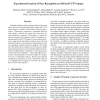Free Online Productivity Tools
i2Speak
i2Symbol
i2OCR
iTex2Img
iWeb2Print
iWeb2Shot
i2Type
iPdf2Split
iPdf2Merge
i2Bopomofo
i2Arabic
i2Style
i2Image
i2PDF
iLatex2Rtf
Sci2ools
113
Voted
AVSS
2008
IEEE
2008
IEEE
Experimental Analysis of Face Recognition on Still and CCTV Images
Although automatic identity inference based on faces has shown success when using high quality images, for CCTV based images it is hard to attain similar levels of performance. Furthermore, compared to recognition based on static images, relatively few studies have been done for video based face recognition. In this paper, we present an empirical analysis and comparison of face recognition using high quality and CCTV images in several important aspects: image quality (including resolution, noise, blurring and interlacing) as well as geometric transformations (such as translations, rotations and scale changes). The results show that holistic face recognition can be tolerant to image quality degradation but can also be highly influenced by geometric transformations. In addition, we show that camera intrinsics have much influence – when using different cameras for collecting gallery and probe images the recognition rate is considerably reduced. We also show that the classification p...
Related Content
| Added | 29 May 2010 |
| Updated | 29 May 2010 |
| Type | Conference |
| Year | 2008 |
| Where | AVSS |
| Authors | Shaokang Chen, Erik Berglund, Abbas Bigdeli, Conrad Sanderson, Brian C. Lovell |
Comments (0)

